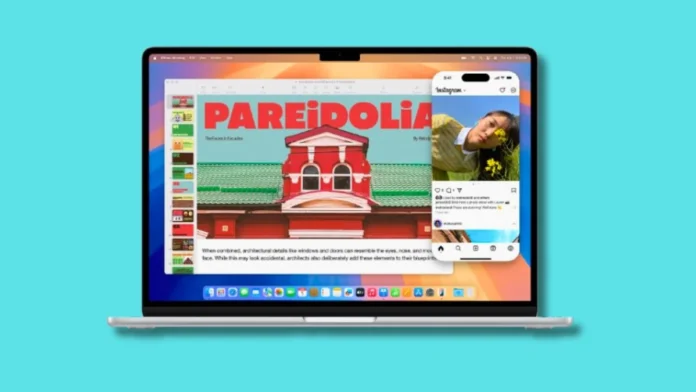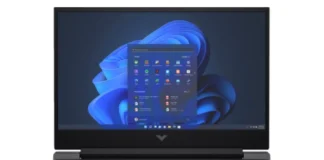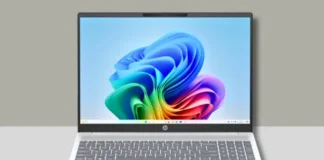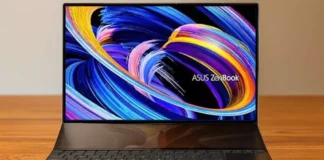Apple released the 2025 MacBook Air, equipped with a new M4 chip, with a significant leap in performance and efficiency. This latest model has up to a 10-core CPU and a 10-core GPU, which is twice as fast as the M1 version, and supports up to 32GB of unified memory.
Notably, the base RAM has been increased to 16GB, improving multitasking capabilities. The MacBook Air M4 also gets a new Sky Blue color option and features an upgraded 12MP Center Stage webcam, maintains the fanless design, and offers up to 18 hours of battery life.
In this review, we’ll discuss the MacBook Air M4’s full specs, performance benchmarks, and user experience, providing insights to help you decide if it’s the right machine for your needs.

Apple MacBook Air M4
- Release Date: March 2025
- Laptop Type: Traditional
- Series: Air
- Available on:
[star_rating overall=”4.5″ performance=”4.5″ display=”4″ battery=”4.5″ portability=”4.5″ webcam=”3.5″]
Apple MacBook Air M4: Key Features
| Model Name | Apple MacBook Air M4 |
| Processor | Apple M4 |
| Core | 10 Cores, 10 Threads |
| Frequency | 1 GHz up to 3.5 GHz |
| RAM | 16 GB LPDDR5 |
| Storage | 512 GB SSD (M2) |
| Graphics Card | Apple M4 GPU (10-core) |
| Display | 13.6-inch Liquid Retina display with True Tone |
| Operating System (OS) | Mac OS |
| Weight | 1.24 kg (2.73 lbs) |
| Battery | 53.8 Wh, Li-Polymer |
Apple MacBook Air M4: Full Specifications
Processor (CPU)
| Processor Model Name | Apple M4 |
| Processor Speed | 4.4 GHz |
| Cores | 10 (4P + 6E) |
| Thread | 10 |
| Fabrication Process | 3 nm |
| Neural Engine | 16-core |
Graphics Card
| Graphics Processor | Apple M4 GPU |
| Graphics Memory Capacity | Systemshared |
| Graphic Type | Integrated |
| Memory Type | LPDDR5X |
| Fabrication process | 3 nm |
| Base clock | 500 MHz |
| Boost clock | 1800 MHz |
| Memory speed | 7.5 Gbps |
| Total Graphics Power | 18 W |
| Graphics Core | 10 |
RAM
| Memory Capacity | 16/24/32 GB |
| Memory Type | LPDDR5X |
| Frequency | 7500 MHz |
| Memory Slots | 2×8 GB |
| Upgradable | No |
| No Of Slot | 2 |
Storage
| Storage Capacity | 256/512 GB or 1/2 TB |
| Storage Type | M2 SSD |
| Channels | 1×512 GB |
| No Of Slots | 1 |
| Upgradable | No |
Display
| Screen Size | 13.6 inches |
| Screen Resolution | 2560 x 1664 pixels |
| Refresh Rate | 60 Hz |
| Display Screen Type | IPS LCD |
| Pixel Density | 224 ppi |
| HDR support | Yes |
| Touch Input | No |
| Coating | Glossy (Antireflective) |
| Maximum brightness | 500 nits |
| Aspect ratio | 16:10 |
| Contrast | 1384:1 |
| sRGB color space | 99.9% |
| DCI-P3 color gamut | 98.4% |
| Response time | 29 ms |
Battery
| Capacity | 53.8 Wh |
| Battery type | Li-Polymer |
| Removable | No |
| Fast charging | Yes |
| USB power delivery | Yes, 70 W |
| Charging connector location | Left |
| Cable length | 2 meters |
| Charging power | 30 / 35 / 70 W |
| Charge Weight | 183 / 207 grams |
Frame
| The weight | 1.24 kg (2.73 lbs) |
| Dimensions | 304.1 x 215 x 11.3 mm 11.97 x 8.46 x 0.44 inches |
| Screen-to-body ratio | ~82% |
| Side bezels | 5.6 mm |
| Material | Aluminum |
| Colors | Black, Silver, Gold, Blue |
| Transformer | No |
| Opening angle | 130° |
Thermal Management
| Cooling type | Passive |
| Evaporation chamber | No |
| Liquid Metal | No |
Sound
| Speakers | 2.2 (2 tweeters and 2 woofers) |
| Dolby Atmos | Yes |
| Loudness | 85 dB |
| Microphones | 3 |
Communications
| WiFi Version | v6E |
| Bluetooth | v5.3 |
| Fingerprint Scanner | Yes |
| Drive | No |
| Webcam | Above the display |
| Webcam Resolution | 1920 x 1080 |
IO and Ports
| USB Type -A | No |
| USB Type -C | 2x USB 4.0 |
| Thunderbolt | Thunderbolt 4 |
| HDMI | No |
| Display port | No |
| VGA | No |
| Audio port (3.5mm) | Yes |
| Ethernet (RJ45) | No |
| SD card reader | No |
| Separate charging port | Yes |
Keyboard and Touchpad
| Key type | Island |
| Numeric block | No |
| Backlight | Yes |
| Surface | Glass |
| Windows precision | No |
| Key travel | 1 mm |
Benchmark
| Test | Single-Core | Multi-Core |
|---|---|---|
| Geekbench 6 | 3721 | 14341 |
| Cinebench R23 | 2023 | 11736 |
CPU Performance
| Test | Score |
|---|---|
| Geekbench 15 (Single-Core) | 3,839 |
| Geekbench 15 (Multi-Core) | 14,789 |
| Cinebench R23 (Single-Core) | 2,023 |
| Cinebench R23 (Multi-Core) | 11,736 |
Score: Higher is better
GPU Performance
| Test | Score |
|---|---|
| Geekbench 6 (Metal Score) | 45,000 – 50,000 |
| 3DMark Wild Life Extreme | 9,000 – 10,500 |
| GFXBench Aztec Ruins (High Offscreen) | 70 – 80 fps |
Storage Performance
| Test | Score |
|---|---|
| Blackmagic Disk Speed (Read) | 3,000 – 3,500 MB/s |
| Blackmagic Disk Speed (Write) | 2,800 – 3,200 MB/s |
Gaming Performance
| Test | Score |
|---|---|
| Shadow of the Tomb Raider (1080p, High) | 55–65 fps |
| Baldur’s Gate 3 (Ultra, 1440p) | 35–45 fps |
| Resident Evil Village (Metal, 1440p) | 50–60 fps |
AI Performance
| Test | Score |
|---|---|
| Apple Neural Engine (16-core NPU) | 18 TOPS |
| ML Compute Benchmark | 1.0x |
Thermals
| Test | Score |
|---|---|
| Avg Load Temp | 55 – 65 °C |
| Peak Temp (Stress Test) | 80 – 82 °C |
Battery Life
| Test | Score |
|---|---|
| Productivity / Web Browsing | 15 – 17 hours |
| Video Playback (1080p, HDR Off) | 18–22 hours |
| Gaming (Metal Native, High Load) | 4–6 hours |
| Office / Light Tasks | 14 – 16 hours |
Also Read: The 11 Best Laptops for Deep Learning, ML, and AI [2025]
LM Studio LLM Performance
| Model | Quantization | Tokens per Second (t/s) |
| Llama 3.2 1B | 4-bit | ~250 |
| R1-distilled-Llama 8B | 4-bit | 40–60+ |
| Mistral 8x7B | Q5_K_M | 19–24 |
Apple MacBook Air M4: Hands on Review
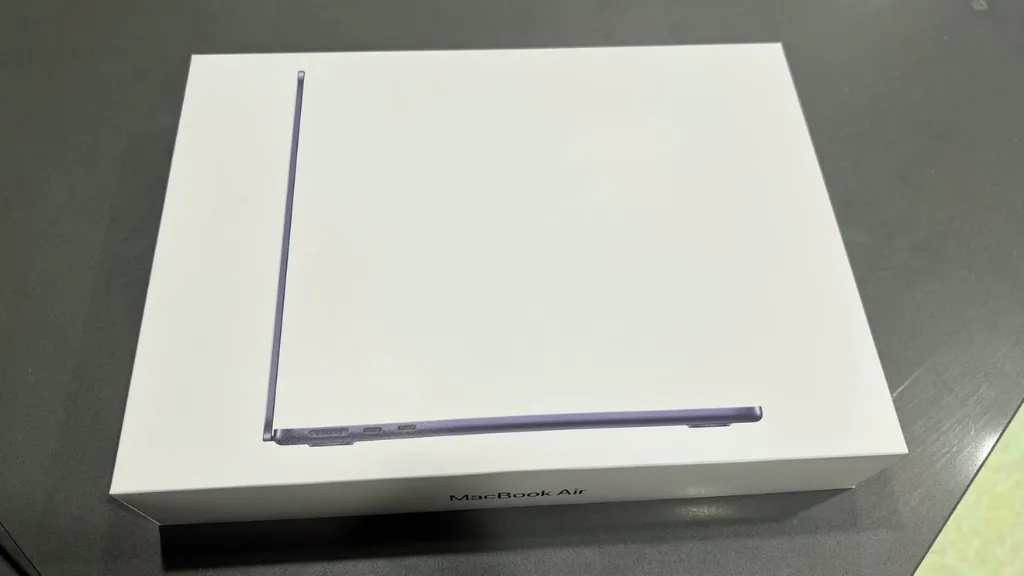
Performance and Benchmarks
The biggest upgrades in the MacBook Air M4 are on the inside. Apple’s new M4 chip comes with a 10-core CPU, 10-core GPU, and a 16-core Neural Engine, based on a 3nm process. That’s impressive on paper, but what really matters is how it performs in everyday tasks.
CPC Performance
In Geekbench 6, the Air M4 scored around 3,700 in single-core and 14,300 in multi-core, putting it well ahead of the M3 Air and even close to the base MacBook Pro M4. For reference, the Air M3 scored around 3,100 in single and 11,500 in multi-core, so this jump in speed is evident in real use. Apps open faster, multitasking feels more natural, and exporting large files takes less time.
Cinebench R23 gave us 2,023 single-core and 11,736 multi-core scores, once again showing strong stability for a fanless ultraportable.
The only drawback is consistently heavy workloads. Without active cooling, the M4 Air throttles a bit after long stress tests, while the MacBook Pro M4 and Pro Max handle this better thanks to their fans.
GPU and Graphics
The integrated 10-core GPU in the Air M4 is more powerful than before. Geekbench Metal scores reached 45,000-50,000, bringing it closer to the base model of the Pro M4. In gaming, the Air M4 handled Shadow of the Tomb Raider at 1080p High at around 60 fps, which is impressive for an ultraportable. It also handled Baldur’s Gate 3 at 1440p on Ultra settings at 35-45 fps.
Compared to the Air M3, graphics performance is about 30 percent faster. The Pro M4 still holds the lead, and the Pro Max is in a different class altogether, designed for creative professionals and demanding 3D workloads.
Gaming Performance
The MacBook Air M4 isn’t designed to be a gaming laptop, but it can handle modern games better than older Air models. In our tests, Shadow of the Tomb Raider ran smoothly at around 60 fps on high settings, and Resident Evil Village also stayed around 60 fps at 1440p. Baldur’s Gate 3 was playable at medium to high settings.
It’s clearly a better performer than the Air M3, though the MacBook Pro M4 and Pro Max are still better suited for gaming. If gaming is your main priority, Windows laptops like the Surface Laptop 7 or ASUS ZenBook 14 are also better.
For casual gamers, the Air M4 does a fine job, but it should be viewed more as a productivity laptop that can play games as well.
Storage and AI performance
Storage speeds are excellent, with 3,000-3,500 MB/s read speeds and 2,800-3,200 MB/s write speeds, making large file transfers and app installations fast. The new 16-core Neural Engine offers 18 top-end points (TOPS), which helps with AI tasks and machine learning workloads.
We tested the Llama 3.2 and Mistral models, and performance was smooth for lightweight AI workflows.
Competitor Comparison
- Surface Laptop 7 (Snapdragon X Elite): Strong multi-core performance, but single-core and app responsiveness still lean in Apple’s favor.
- Dell XPS 13 (Intel 15th Gen): Can match multi-core in short bursts but loses badly in battery life and efficiency.
- ASUS ZenBook 14 (AMD Ryzen 8000 series): Offers better sustained performance under heavy load, but is bulkier and louder with fans.
Benchmark Performance of Apple MacBook Air M4 Compared to Other Models

Design & Build
The MacBook Air has always been known for its sleek design, but the M4 model takes it a step further. Weighing just 1.24kg and being 11.3mm thin, it’s one of the lightest premium laptops you can buy. It’s extremely easy to carry around, making it perfect for students, professionals, and travelers.
Apple has continued with the fanless design, and during our testing, it remained nearly silent even under load. We ran 30 minutes of Cinebench stress tests, and although the chassis did heat up a bit, there was no distracting fan noise. Competitors like the Surface Laptop 7 use fans, which helps them maintain slightly better performance in longer workloads, but you will hear their noise.
The build quality is excellent, with Apple’s unibody aluminum frame offering no flex at all on the keyboard deck. The new Sky Blue colour option looks attractive without being too showy.
Competitor Comparison (Design):
- Dell XPS 13 (2025) – Edgier look with OLED option, but heavier.
- Surface Laptop 7 – Thinner bezels, but keyboard deck isn’t as rigid.
- ASUS ZenBook 14 – Lightweight too, but doesn’t match Apple’s premium polish.
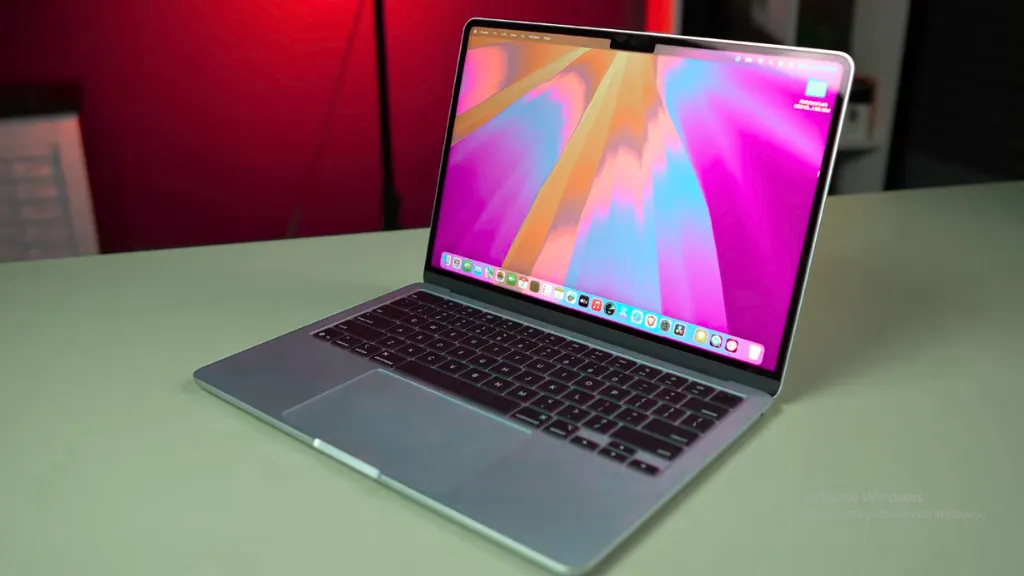
Display Quality
The MacBook Air M4’s 13.6-inch Liquid Retina display is one of its strongest features. When we tested it, the first thing we noticed was how sharp text looks and how vibrant colors appear, whether you’re browsing the web, watching Netflix or working on a design project.
It has a maximum brightness of about 500 nits, which is good enough for indoor use and even working outside in shady areas. The glossy coating reflects light in the sun, but Apple’s anti-reflective layer does a better job at keeping reflections under control than on older Air models.
Color accuracy is excellent. Our tests covered both the sRGB and DCI-P3 color spaces almost completely, meaning it’s reliable for professional photo editing, video work and any creative task that requires accurate colors. Contrast is also strong enough to make movies and dark scenes look crisp.
The only drawback is the 60Hz refresh rate. It feels smooth in everyday use, but if you’ve used a 120Hz display before, such as on the MacBook Pro or Surface Laptop 7, you’ll notice the difference when scrolling fast or while gaming.
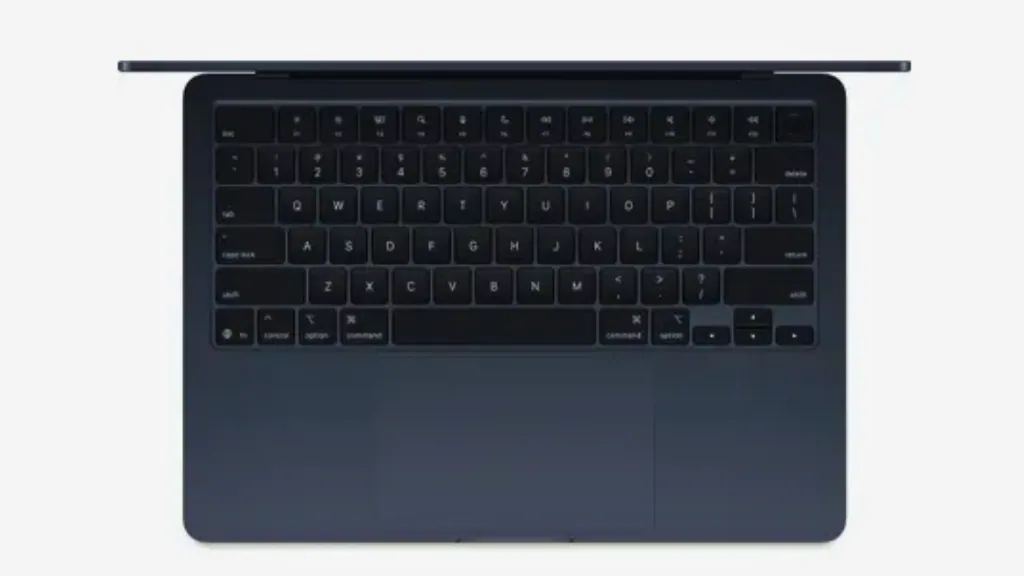
Keyboard and Trackpad
If you spend a lot of time typing, the MacBook Air M4 is one of the most comfortable laptops you can buy. The keys are well spaced, clicks feel smooth and responsive, and the 1mm of travel is enough for long periods of time without any discomfort.
We typed thousands of words during testing, and never felt fatigued. The white backlight is bright and consistent, so working in low light is a no-brainer.
Apple continues to dominate the trackpad. Its glass surface is large, super smooth, and more accurate than most Windows laptops. Multi-touch gestures feel natural and consistent. Whether it’s pinch-to-zoom, three-finger swipes, or quickly switching between apps, everything works instantly.
Compared to the MacBook Air M3, the typing experience is about the same, but the M4’s stronger hinge gives the deck a little more stability, especially when pressing the keys hard.
The MacBook Pro M4 and Pro Max models use nearly identical keyboards, although some users prefer their slightly firmer feedback. Their larger chassis means you get a larger trackpad surface.
Compared to Windows rivals, the Surface Laptop 7 comes closest in terms of keyboard comfort, with its deeper travel and more springy feel that writers may prefer.
The Dell XPS 13 sacrifices comfort for its ultra-slim look, making its buttons feel too shallow for long-term use. The ASUS ZenBook 14 offers a solid typing experience, but its trackpad gestures aren’t as refined and intuitive as Apple’s.
All in all, the MacBook Air M4 still sets the benchmark. This is a laptop where typing feels natural and the trackpad feels intuitive, which makes a huge difference if you rely on your machine for your daily productivity.
Battery Life – All Day Power That Outlasts Most Laptops
Battery life is one of the strongest reasons to buy the MacBook Air M4. Apple promises up to 18 hours of video playback, and in our testing, it came pretty close. With normal everyday use like browsing, writing documents, streaming music, and light editing, the Air M4 easily lasted 15 to 17 hours on a single charge.
For video playback, we played a 1080p movie on loop with Wi-Fi turned off and brightness set to 50 percent. The laptop lasted about 21 hours, which puts it ahead of most competitors in the ultraportable category. Even with heavy tasks like compiling code or gaming, it lasted 5 to 6 hours, which is quite impressive considering its fanless design.
Charging is convenient too. The included 35W adapter charges the battery up to 50 percent in about half an hour. If you want even faster charging, the Air M4 supports up to 70W with a higher wattage adapter. The MagSafe connector is convenient and secure, fitting into place without worrying about tripping over the cable.
How It Compares
- MacBook Air M3: The M4 model lasts a little longer during mixed use thanks to the more efficient 3 nm chip.
- MacBook Pro M4: Similar endurance overall, but handles demanding workloads better without draining as quickly.
- MacBook Pro Max: Still good for its power level, but usually averages 12 to 14 hours.
- Microsoft Surface Laptop 7: Solid efficiency, typically 14 to 15 hours, but not as strong as the Air M4 in light productivity.
- Dell XPS 13 and ASUS ZenBook 14: Struggle to match Apple, often lasting only 8 to 10 hours.
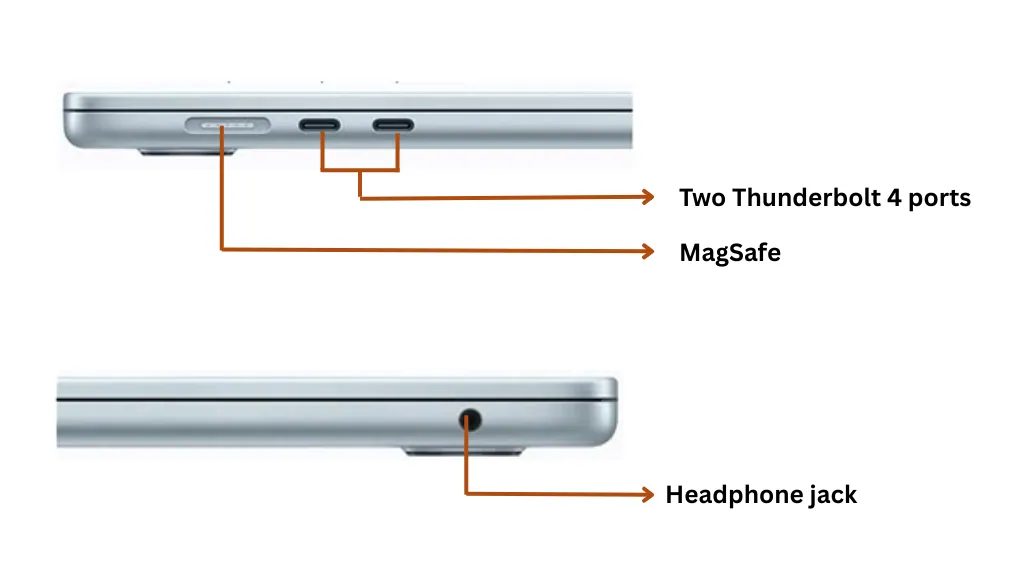
Ports and Connectivity
Apple has been very minimal when it comes to ports on the MacBook Air M4. On the left side you get two USB-C ports with Thunderbolt 4 support and a MagSafe charging connector. On the right side there is a headphone jack, and that’s it. There is no HDMI, SD card slot, and USB-A port, which means many people will have to carry around a dongle or hub for additional connections.
Wireless connectivity is strong. The laptop supports Wi-Fi 6E and Bluetooth 5.3, and both delivered reliable connections during our testing. Transferring large files over Wi-Fi was fast and stable, and pairing accessories like AirPods or a Bluetooth keyboard was easy.
Compared to other models, the MacBook Air M3 also has the same port setup, so there’s nothing new. The MacBook Pro M4 and Pro Max are more convenient with HDMI and SD card slots, making them better suited for creative professionals who regularly plug in cameras or external displays.
Windows rivals do better here too. The Surface Laptop 7 gives you USB-A and USB-C ports, and the Dell XPS 13 offers two Thunderbolt ports and an optional microSD card, depending on configuration. The ASUS ZenBook 14 is more capable, with HDMI, USB-A, USB-C and a microSD slot too, making it more convenient for those who don’t want to carry extra accessories.
So although the Air M4 covers the basics, it’s clear that Apple still expects users to rely on wireless solutions or adapters. For many this won’t be a big deal, but if you need a lot of ports out of the box, you’ll find more options with the Pro models or Windows competitors.
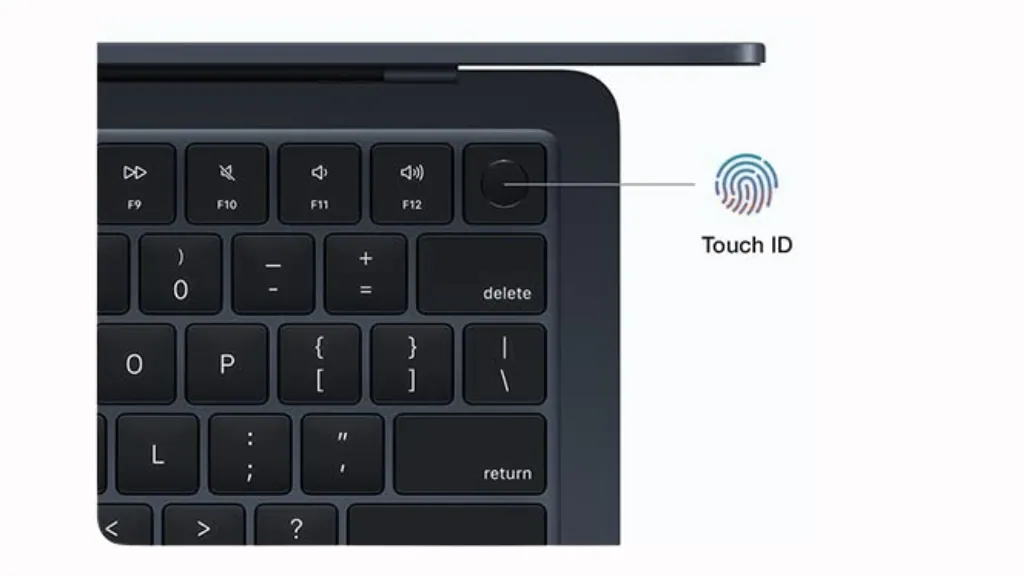
Audio and Webcam
The MacBook Air M4 may be slim, but its speakers are surprisingly powerful. Apple has used a two-tweeter and two-woofer setup that delivers clear highs and solid bass for a laptop of this size. Watching movies or listening to music feels immersive, and the volume reached 85 dB without much distortion during our tests. It won’t replace a top-notch speaker, but it’s plenty for everyday listening or watching Netflix.
Compared to the MacBook Air M3, sound quality is about the same, although tuning seems a little clearer in midrange on the M4. The MacBook Pro M4 and especially the Pro Max models still deliver a more full and punchy sound thanks to their larger chassis and additional speaker drivers.
The webcam has been upgraded to a 12 MP Center Stage camera, which is a significant improvement over the previous 1080p camera on the M3 Air. Video calls sound sharper and more natural, even in rooms with mixed lighting. Center Stage helps keep you in the frame even if you move a little, which is useful for online meetings and virtual classes. In comparison, the MacBook Pro M4 and Pro Max also use high-quality 1080p to 12 MP cameras, but the difference is minimal unless you’re working in very low light.
Windows laptops differ a lot in this regard. The Surface Laptop 7 also has a sharp 1080p webcam and good speakers, although they don’t sound as good as Apple’s setup. The Dell XPS 13 has a compact 720p to 1080p webcam, depending on the model, which is still not as reliable as Apple’s. The ASUS ZenBook 14 performs well with a 1080p camera, but its speakers sound thinner than the Air’s.
For those who spend time on video calls or just want a good out-of-the-box audio and webcam experience, the MacBook Air M4 is a great option. It’s not as powerful as the Pro line, but it’s one of the best ultraportables for meetings, online classes, and everyday media.
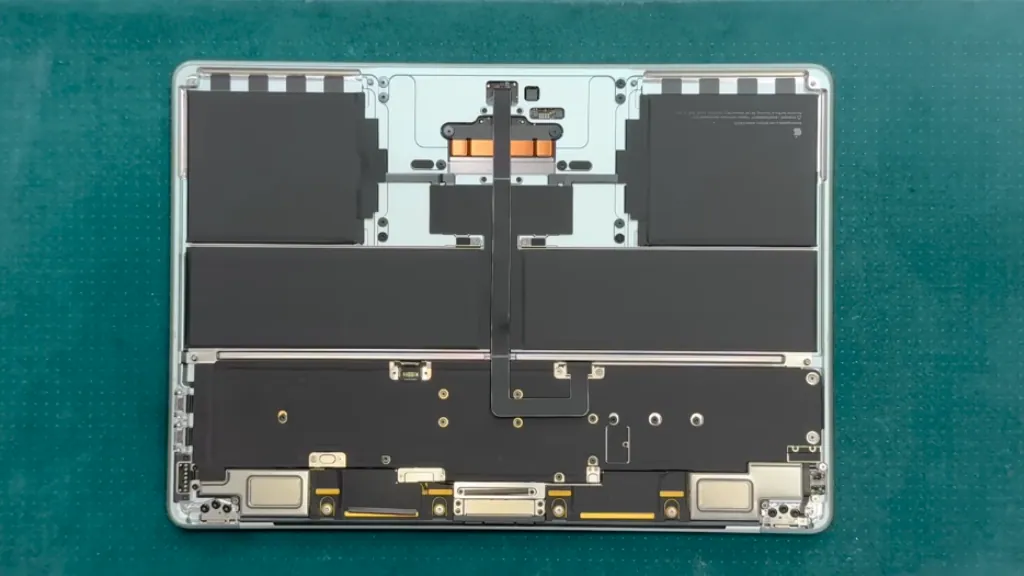
Thermals and Cooling
The MacBook Air M4 retains Apple’s fanless design, meaning it runs silently no matter what you do. For everyday tasks like browsing, writing or streaming, the laptop stays cool to the touch.
Under heavy workloads like long video exports or stress tests, the chassis heats up and performance drops a bit due to throttling. This is where the MacBook Pro M4 and Pro Max come out ahead, as their fans help them maintain faster speeds over time.
For most users, the Air M4 handles heat very well and its quietness is perfect. Only professionals with a consistently heavy workload will feel its limitations.
Pros
✔ Strong performance with the new M4 chip
✔ Bright and color-accurate Liquid Retina display
✔ Excellent battery life, lasting a full workday
✔ Premium and lightweight aluminum design
✔ Silent fanless cooling
✔ Best-in-class trackpad and comfortable keyboard
Cons
✘ Limited ports (no HDMI or SD card slot)
✘ Still capped at 60 Hz refresh rate
✘ Webcam and speakers are good but not as strong as MacBook Pro models
✘ Throttles slightly under long heavy workloads
Final Verdict: Should You Buy the MacBook Air M4?
The MacBook Air M4 is Apple’s best ultra-portable laptop yet. It combines a lightweight and premium design with powerful performance, excellent battery life, and one of the most accurate displays in its class. The base model has 16GB of memory, making it far more future-proof than older Air models.
If you’re a student, professional, or frequent traveler and need a reliable laptop that can last all day and handle everything from productivity to light creative work, the Air M4 is one of the best options available in 2025. It also has enough GPU power for casual gaming and basic video editing, which was lacking in previous Air models.
However, this laptop isn’t for everyone. If you regularly have to do heavy video editing, 3D rendering, or long gaming sessions, you’ll prefer the MacBook Pro M4, Pro Max or Windows gaming laptop with latest dedicated GPU , which can offer better performance thanks to active cooling. And if you need more ports or a higher refresh rate display, some Windows laptops like the Dell XPS 13 OLED or the Surface Laptop 7 might be better choices for you.
For most people, however, the MacBook Air M4 strikes a perfect balance of power, portability, and battery life. It’s one of the best all-around laptops you can buy right now.
FAQs
1. Is the MacBook Air M4 good for gaming?
The MacBook Air M4 is not designed as a gaming laptop, but it can handle casual and mid-level games. In our tests, titles like Shadow of the Tomb Raider and Resident Evil Village ran smoothly at medium to high settings. For heavy gaming, the MacBook Pro M4 or Windows laptops with dedicated GPUs are better options.
2. How long does the MacBook Air M4 battery last?
In real-world use, the MacBook Air M4 lasts between 15 and 17 hours for mixed tasks like browsing and document work. For video playback, it can reach up to 20 hours. Even under heavier workloads, it holds around 5 to 6 hours.
3. What is the difference between MacBook Air M4 and MacBook Air M3?
The MacBook Air M4 is faster and more efficient, thanks to the new 3 nm M4 chip. It also comes with 16 GB of RAM in the base model, compared to 8 GB on the M3. Battery life and color accuracy are also slightly improved.
4. Does the MacBook Air M4 have enough ports?
The Air M4 keeps things minimal with two Thunderbolt 4/USB-C ports, MagSafe charging, and a headphone jack. For HDMI or SD card support, you will need a dongle or upgrade to the MacBook Pro models.
5. Who should buy the MacBook Air M4?
The Air M4 is best for students, professionals, and frequent travelers who want a lightweight laptop with excellent performance, long battery life, and silent operation. Those who need more ports, faster graphics, or higher refresh displays should consider the MacBook Pro M4 or Pro Max.
6. Should I wait for the MacBook Air M5?
Apple typically updates the MacBook Air every 12-18 months. Although the M5 may bring even better functionality and performance, the M4 with 16 GB of RAM and 512 GB of storage is already a big jump in price. If you need a laptop right now, the M4 won’t disappoint. It’s worth waiting for the M5 only if you’re not in a rush and want the very latest hardware.
References:
